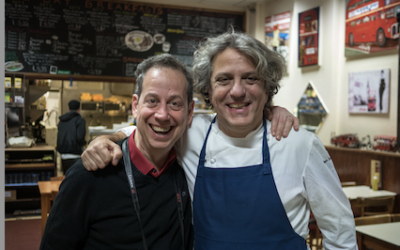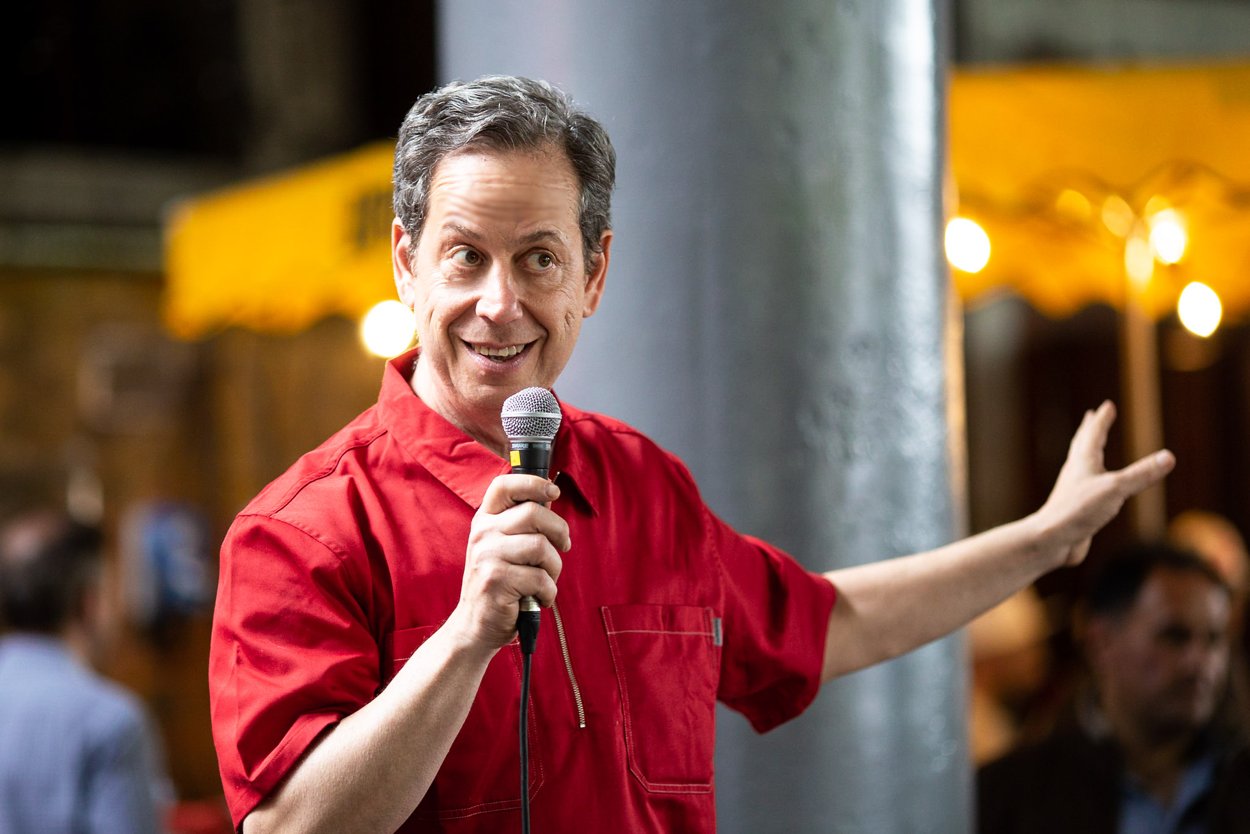
Danny Meyer (center), Shake Shack CEO Randy Garutti (left) and me at
BurgerMonday-on-a-Wednesday preview party, Covent Garden.
Photo by Simon Kimber.
Back in the early days of the Union Square Cafe, any difficulty first-time diners had reconciling the New York restaurant’s accolades with its informality rarely lasted through dinner. With a comprehensive approach to attentive service that would become his signature, owner Danny Meyer proved that a smart-casual, feel-good restaurant could be as accomplished as any multi-starred French one.
“For me it was never about the pomp and circumstance of the experience,” says Meyer, who was 27 when he opened the restaurant, his first, in 1985. “It was about what was on the plate and the generosity with which it was served to me. What led to Union Square Café was loving a bistro in Provence or a trattoria in Rome. I think Shake Shack is a successor to that.”
 You may have to watch my short video interview at the bottom of this post to get what Meyer is driving at. Otherwise any similarity between a Roman trattoria and Shake Shack may be no more apparent to you today than it would have been to New Yorkers in 2004, when Meyer opened the fast-food kiosk in Midtown Manhattan’s Madison Square Park. This time, the difficulty for some was in reconciling the reputation of the visionary restaurateur behind not one but two winners of the James Beard Award for Outstanding Restaurant in the USA, Union Square Cafe and Gramercy Tavern, with that of a hot dog vendor in the park.
You may have to watch my short video interview at the bottom of this post to get what Meyer is driving at. Otherwise any similarity between a Roman trattoria and Shake Shack may be no more apparent to you today than it would have been to New Yorkers in 2004, when Meyer opened the fast-food kiosk in Midtown Manhattan’s Madison Square Park. This time, the difficulty for some was in reconciling the reputation of the visionary restaurateur behind not one but two winners of the James Beard Award for Outstanding Restaurant in the USA, Union Square Cafe and Gramercy Tavern, with that of a hot dog vendor in the park.
What could possibly have moved Meyer to trade in table service, cloth napery, impeccable cooking and 99 percent of all vegetables for split hot dogs and, later, smashed double cheeseburgers in paper wrappers?
 Any head-shaking about Shake Shack did little to shorten the wait for hot dogs and especially burgers, sadly, some would say. Meyer’s high standing and standards gave even New York’s most sophisticated grownups cover to eat like kids again. Kids liked eating like kids, too, as they always have. Long queues begat longer ones, as well as more Shake Shacks in New York, up-and-down the East Coast of the USA and overseas (the Middle East and Turkey).
Any head-shaking about Shake Shack did little to shorten the wait for hot dogs and especially burgers, sadly, some would say. Meyer’s high standing and standards gave even New York’s most sophisticated grownups cover to eat like kids again. Kids liked eating like kids, too, as they always have. Long queues begat longer ones, as well as more Shake Shacks in New York, up-and-down the East Coast of the USA and overseas (the Middle East and Turkey).
Now it’s London’s turn to be confounded by the Meyer touch. This Friday at 10am he opens Britain’s first Shake Shack in the Market Building of Covent Garden Piazza (sneak peek here.) His team has anglicised their operation, substituting Scottish Aberdeen Angus beef for American mince, incorporatingCumberland sausages in the selection of “flat-top” hot dogs and sourcing mix-ins for the frozen custard ice creams affectionately known as “concretes” from St John Bakery and chocolatier Paul A. Young.
But the made-in-the-UK push has its limits. The London Shake Shack will manage without its proprietary American beef blend from Pat La Frieda, the New Jersey burger meat mogul, but not without potato rolls from Martin’s. Those buns will be shipped to London from Pennsylvania. And much as Meyer is wishing for queues – Shake Shack wouldn’t be Shake Shack without them – he draws the line when it comes to using the British term queues. For him success at Covent Garden or wherever else Shake Shack ventures will always be measured in lines.
Cause and Effect
 It’s been the effect, namely the queues, as much as cause, specifically the superior fast-food, that’s transformed Shake Shack into a cultural phenomenon. The iconic home of the great American hamburger used to be the drive-in, with large cars parked around the burger stand, rock ‘n’ roll blaring from their radios.
It’s been the effect, namely the queues, as much as cause, specifically the superior fast-food, that’s transformed Shake Shack into a cultural phenomenon. The iconic home of the great American hamburger used to be the drive-in, with large cars parked around the burger stand, rock ‘n’ roll blaring from their radios.
At Shake Shack urban pedestrians join a queue, instantly connecting with a random community of know-it-alls, have-it-alls and newbies who ought fear becoming one of them. Once you’ve stepped into the queue you’re on the inside and in position to broadcast out through texts and social media. Meyer could not have foreseen Twitter when he dreamed up Shake Shack, nor did he invent Instagram as an effective way to promote it. But the barrage of this is me on line at Shake Shack photos and here’s me with my ShakeBurger snapshots does make it look as though micro-blogging and photo-sharing were part of some ingenius business plan.
The global burger boom is much bigger than Meyer, much bigger than Shake Shack, much bigger even than burgers. In the past we went out to eat to go out to eat. Now we go out to, as Meyer suggests, go home, to, in a certain sense, return home: We crave comforting food that evokes memories, only we insist that it be special. Our shared desire is, to use my young&foodish mantra, food we know as we’ve never known it.
“People want the experience to be easier and more accessible than it’s ever been,” says Meyer. “People want it to taste better than they’ve ever wanted it to taste.”



Thank you for this great article!! We are excited about our rolls in the UK!!
Have to say I am a little bit excited having seen all the photos go up on Instagram this week by those lucky souls that got a sneak peak!